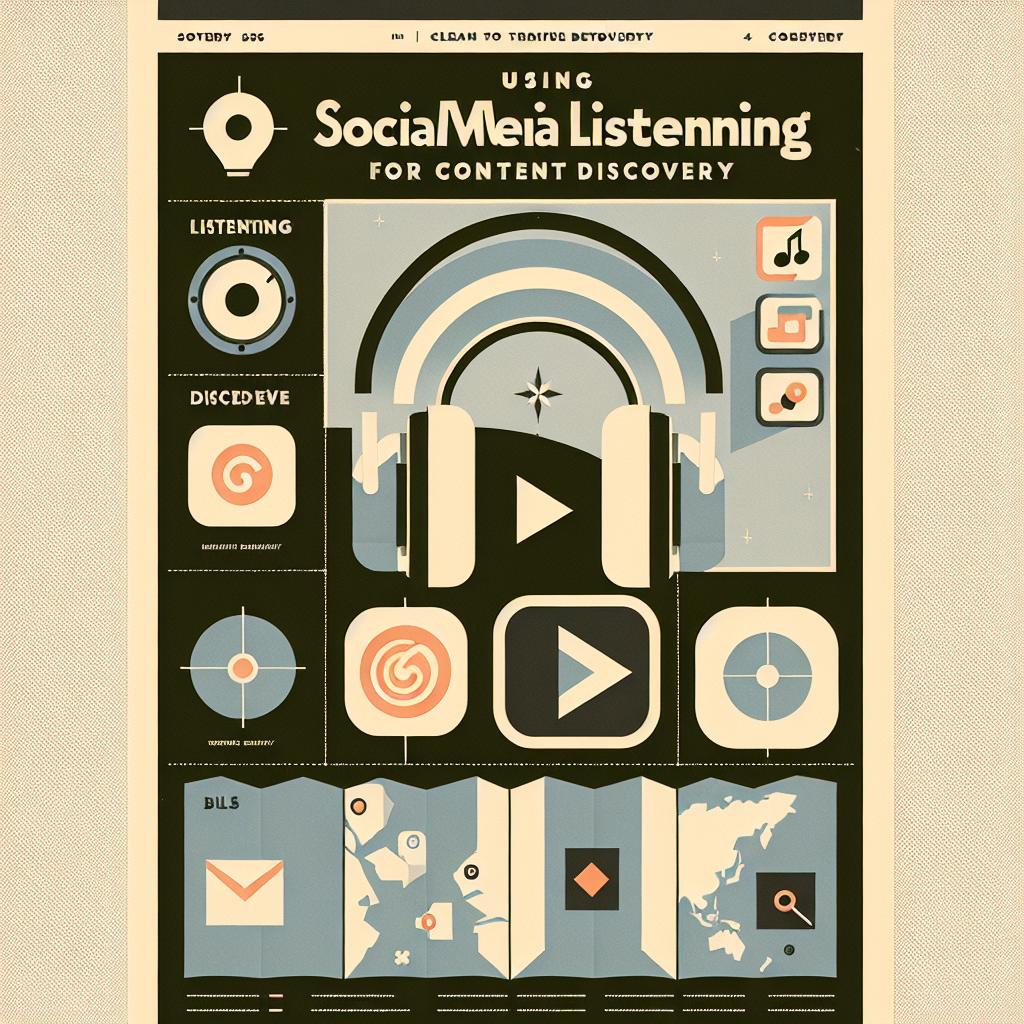Introduction to Social Media Listening
Ever wondered how to keep your finger on the pulse of evolving customer sentiment? Well, social media listening might be your answer! This detailed guide will explore the essence of social media listening, a powerful tool used by brands worldwide to understand and engage with their audience.
Throughout this article, we’ll break down the basics, explain how it works, and list some essential tools to help you get started. Plus, we’ll discuss the tangible benefits of adopting social media listening in your business strategy – everything from improved customer engagement and brand health monitoring to competitive insights and even content strategy.
Finally, we’ll share some solid steps to kickstart your own social media listening strategy. So, are you ready to tune in to the buzz around your brand? Let’s get started!
Understanding the Social Media Listening Method
Defining Social Media Listening
Social media listening involves tracking online conversations around specific phrases, words, or brands and then leveraging these insights to discover opportunities.
Unlike social media monitoring, which only tracks metrics like engagement and reach, listening focuses on understanding the bigger picture through context.
How Social Media Listening Works
Social media listening requires specialized tools that can scan the web and social platforms for mentions of your chosen keywords or topics.
These tools provide insights into public sentiment and trending topics.
Here’s how it generally works:
- Select relevant keywords, hashtags, or phrases to monitor.
- Use listening tools to gather data from social media platforms, forums, and blogs.
- Analyze the data to understand audience sentiment and discover emerging trends.
- Take action based on insights, such as adjusting marketing strategies or products.
Benefits of Social Media Listening
Understanding consumer sentiment and industry trends are just the tip of the iceberg. Below are some key benefits:
| Benefit | Description |
|---|---|
| Improved Customer Engagement | Helps brands understand customer needs for more meaningful interactions. |
| Brand Health Monitoring | Tracks how your brand is perceived over time, identifying risks early. |
| Competitive Insights | Offers clues on competitors’ strategies and consumer preferences. |
| Content Strategy | Inspires content ideas based on trending topics and audience interests. |
Useful Tools for Social Media Listening
Several tools can make social media listening easier and more comprehensive. Here are a few popular ones:
- Hootsuite Insights: Offers real-time data and customizable reports.
- Sprout Social: Provides a single platform for listening, analytics, and publishing.
- Brandwatch: Offers deep social intelligence with advanced analytics features.
- BuzzSumo: Great for discovering high-performing content and influencer partnerships.
For further reading on social media listening, check out this guide by HubSpot.
Steps to Implement a Social Media Listening Strategy
Getting started with social media listening doesn’t have to be complicated. Follow these steps:
- Define your goals and what you hope to achieve with social media listening.
- Choose keywords and phrases that align with these goals.
- Select tools that best meet your needs and budget.
- Set up automated alerts and regular reports for streamlined analysis.
- Regularly review and adjust your strategies based on the insights collected.
Exploring the Intricacies of Social Media Listening
Recognizing the Need for Social Media Listening
Be it a multinational corporation or a small-sized business, understanding – and effectively leveraging – customer sentiment is vital for success. Traditional market research, while useful, isn’t as timely or comprehensive as social media listening. Additionally, social media listening comes with the exponential advantage of covering a vast array of sources, such as user-generated content, professional and amateur reviews, topical discussions, and more.
Deepening the Understanding of Social Media Listening Mechanics
Social media listening tools not only identify the use of specific keywords, but they also categorize and analyze the sentiment associated with these words. Consider it akin to uncovering the emotional undertone of the narrative – whether positive, negative, or neutral. This helps brands in identifying potential crises, understanding the efficacy of marketing campaigns, and recognizing influential figures amongst their audience.
Types of Insights Gained through Social Media Listening
The insights gathered through social media listening go beyond surface-level audience perception. They offer valuable, multi-faceted information, including:
- Trigger Points: Identifying specific topics, news, or events that lead to a spike (or drop) in brand mentions or sentiment.
- Brand Advocates and Detractors: Sorting audience members into promoters, passives, and detractors based on their expressed sentiments.
- Influencer Identification: Spotting influential figures in your audience that can amplify your brand’s message.
- Framing Social Conversations: Understanding the context in which your brand is mentioned alongside topics or other brands.
Expanding the Benefits of Social Media Listening
The potential use of social media listening extends beyond the traditional aspects such as reputation management and competitive insights. For instance,
| Expanded Benefit | Description |
|---|---|
| Product Development | Suggestions, feedback, or complaints visible through listening can inspire product improvements or new product innovations. |
| Customer Service | Listening can aid in proactive customer service, addressing issues even before they become big problems. |
| Employee Engagement | Internal social media platforms can be monitored too, enabling employers to gauge staff sentiment and act accordingly. |
| Brand Affinity | Understanding how audiences perceive your brand in comparison to competitors can help in shaping unique selling points and differentiation strategies. |
Exploring Other Social Media Listening Tools
While the following tools are lesser-known than the likes of HootSuite and BuzzSumo, they offer unique features that can potentially provide a different dimension to social media listening:
- Sendible: Known for its intuitive interface and comprehensive dashboard integrating several social and digital platforms.
- Keyhole: Offers real-time hashtag tracking and keyword monitoring, ideal for campaign-specific listening.
- Awario: Specializes in real-time monitoring and predictive insights, helping businesses anticipate market trends.
- Meltwater: Provides deep-dive analytics with demographic breakdown, sentiment analysis, and potential reach.
For an extensive comparison of social media listening tools, take a look at this roundup by G2.
Facing Challenges in Implementing Social Media Listening
While social media listening presents enormous potential, it isn’t free from challenges. Understanding these can help businesses craft their listening strategy effectively:
- Choosing the Right Tool: With countless options available, selecting the most appropriate tool that caters to your specific needs can be daunting.
- Data Overload: The amount of data generated can be overwhelming, posing a challenge in extracting the most important information.
- Identifying the Right Keywords: Considering the evolving nature of user language, keeping up with the trending keywords can be a challenge.
- Interpreting the Data: Converting insights into actionable strategies requires skill and experience.
How to Use Social Listening Effectively
Setting Clear Objectives
To use social listening effectively, start by defining why you’re doing it. Are you aiming to improve customer service, manage your reputation, or gain a competitive edge? Clear objectives will guide your strategy and ensure you get valuable results.
Choosing the Right Tools for Your Needs
Selecting the right tools is essential in social listening. Different tools offer various features and capabilities:
- Brand24: Focuses on monitoring brand mentions and provides detailed reports on sentiment and reach.
- NetBase Quid: Offers advanced AI for deeper social analytics, ideal for in-depth consumer insights.
These tools help dissect vast online conversations to glean actionable insights tailored to different business needs. For more comprehensive insights, you might explore reviews and comparisons, such as those found on TechRadar.
Defining and Tracking Relevant Metrics
Determine the key performance indicators (KPIs) that align with your objectives. These might include:
| Metric | Description |
|---|---|
| Engagement Rate | Measures the level of interaction with your content like likes, shares, and comments. |
| Brand Mentions | Tracks how often your brand is mentioned across social platforms. |
| Sentiment Analysis | Analyzes the public perception of your brand or campaign (positive, negative, neutral). |
These metrics help you gauge the effectiveness of your social media strategy and make necessary adjustments.
Engaging with Your Audience
Effective social listening isn’t just about collecting data; it requires engaging with users actively. Responding to customer feedback, whether positive or negative, shows that your brand values its customers and is attentive to their needs:
- Proactively address customer complaints to demonstrate your brand’s commitment to quality service.
- Share positive feedback from satisfied customers as part of your marketing strategy.
Incorporating Insights into Business Strategy
Integrate insights from social listening into broader business strategies:
- Refine marketing messages to align better with audience preferences and topical interests.
- Introduce new product features or services in response to consumer demand identified through listening.
- Adjust pricing strategies based on competitor analysis and customer sentiment gathered.
When aligning insights with business strategies, you can better fulfill customer expectations and maintain a competitive advantage.
Continuous Learning and Adaptation
Social listening is dynamic and requires regular updates:
- Stay informed on industry trends and evolving consumer language.
- Adjust keywords and phrases to keep up with shifting consumer discussions and topics.
- Regularly refresh your strategy based on accumulated insights to stay relevant.
Effective social listening requires a commitment to continuous learning and an ability to adapt to changing digital landscapes.
Content Discovery with Social Media Listening
Using Social Media Listening for Content Ideas
Social media listening isn’t just a tool for gauging sentiment or monitoring brand health; it’s a goldmine for content discovery. By analyzing the trends and ongoing conversations, businesses can find inspiration for new topics that resonate with their audience.
- Emerging Trends: By identifying what people are talking about, you can pinpoint trending topics and include these in your content strategy.
- Audience Interests: Listening shows you what your audience cares about, helping you create content that meets their needs and captures their attention.
- Gap Analysis: Discover what topics are underrepresented and fill those gaps with your content.
Leveraging Competitor Insights
Social media listening also allows you to monitor your competitors. This isn’t just about replicating their strategies but understanding what works for them and how you can do it better.
- Content Gaps: Discover topics your competitors haven’t covered and seize the opportunity to lead the conversation.
- Audience Reaction: Analyze the audience’s reaction to competitor content to refine your approach.
Adapting Content Formats
By paying attention to how conversations unfold on social media, you can determine the most effective formats for your content.
- Visual Content: If visual posts are receiving more engagement, consider incorporating infographics or videos.
- Long-Form Content: For topics that generate extensive discussion, consider creating detailed blog posts or guides.
Utilizing User-Generated Content
Social media listening can highlight user-generated content opportunities. Encourage your audience to share their experiences and stories related to your brand, which you can then feature.
- Authenticity: User-generated content typically resonates as more authentic, enhancing your brand’s relatability.
- Engagement: Featuring user content can significantly boost engagement and foster a sense of community.
Handling Sensitive Topics
Social media is ripe with discussions, but not all are simple or safe to engage with. Listening helps you assess potentially sensitive topics by evaluating public sentiment before engaging.
- Reputation Management: Avoid PR crises by gauging sentiment before posting potentially controversial content.
- Social Responsibility: Ensure that your brand’s voice aligns with its values and societal issues carefully.
Exploring how tools like [HubSpot](https://www.hubspot.com) streamline your social media listening can offer additional insights into utilizing these practices effectively.
In Conclusion
To remain competitive in the social media age, businesses must harness insights into public sentiment and industry trends gathered from social media listening. This strategy goes beyond mere data collection. It focuses on understanding the bigger picture through context, involving the process of tracking online conversations around specific phrases, words, or brands, and leveraging these insights to discover opportunities or adjust strategies.
The benefits of social media listening extend from improving customer engagement to brand health monitoring, from gaining competitive insights to inspiring content strategies. The intelligent use of tools like Hootsuite Insights, Sprout Social, Brandwatch, and BuzzSumo can provide real-time data, comprehensive reports, and deep social intelligence.
Frequently Asked Questions – FAQs
What is Social Media Listening?
Social media listening involves tracking online conversations around specific phrases, words, or brands and leveraging these insights to discover opportunities or adjust strategies.
What are the benefits of Social Media Listening?
Benefits include improved customer engagement, brand health monitoring, obtaining competitive insights, and inspiring content strategies.
What is the difference between Social Media Listening and Monitoring?
Unlike social media monitoring, which only tracks metrics like engagement and reach, listening focuses on understanding the bigger picture through context. Social media listening involves leveraging the insights, drawn from careful analysis, to discover opportunities or adjust strategies.
What tools should I use for Social Media Listening?
Some popular tools include Hootsuite Insights, Sprout Social, Brandwatch, and BuzzSumo. These tools can provide real-time data, comprehensive reports, and deep social intelligence which are essential for effective social media listening.






